TMW #098 | What is data?
Welcome to The Martech Weekly, where every week I review some of the most interesting ideas, research, and latest news. I look to where the industry is going and what you should be paying attention to.
👋 Get TMW every Sunday
TMW is the fastest and easiest way to stay ahead of the Martech industry. Sign up to get the full version delivered every Sunday for this and every TMW, along with an invite to the TMW community. Learn more here.
Here’s the week in Martech:
- What is data? Rethinking the role of data
- How much for a metaverse? So far, about $70 billion
- Bytedance goes VR: A new competitor enters the ring
- Everything else: The end of content moderation, the boring curve, Snowflake’s pursuit of Adtech, NFT collapse, conversion APIs, and unethical AB testing
✍ Commentary
What is data?
The question sounds like something a high schooler would ask – of course, everyone who works in the marketing technology industry knows what data is! But lately, our understanding of its purpose and function in a company has become so abstracted, mixed, and confused with so many other concepts that we lack a basic framework for what it actually is.
This essay is an attempt to go deeper into the concept that has, and will continue to define the entirety of our careers. No other word is as important to the marketing technologist as data.
Right now we are living in an era of two opposing forces – the threat data imposes on the safety and wellbeing of everyday people and the marketer’s obsession with it – to collect, analyze and use it.
We’ve never had so much data collected from people before, and because of this, data influences our lives like no other time. A recent Pew study suggested that 6 out of 10 Americans believe that being tracked is unavoidable in modern life, while 79% of them have serious concerns about all the data that is collected about them. To use Spiderman's words - with great power comes great responsibility.
Data's Chernobyl moment
In the same way that Chernobyl changed the trajectory of nuclear energy, a similar re-evaluation of data is coming. This week the Australian telecommunications provider Optus suffered a data breach, losing an estimated 10 million customer records including passports, license numbers, and credit card details. Currently, the debate is centered on whether Optus left an unchecked open API available to their core systems. Oops.
On the other side of the world, Sephora was recently fined more than $1 million by the California government for selling customer data to ad networks without the customer’s consent. The California data privacy protection regulation is set to go into full effect by the first of January, removing the 30-day cure clause. This means that even any company could be exposed to large fines reaching millions with very little warning.
And over in Europe the ICCL is taking Oracle to court with a class action lawsuit claiming that Oracle has detailed profiles of over 5 billion people in their ad network. The ICCL cites data privacy violations in the collection and storage in what is one of the world’s largest repositories of advertising data.
In China, TikTok is attracting greater scrutiny for how the platform makes US data accessible to Chinese team members and by extension the CCP. Scott Galloway, citing privacy and national security concerns suggests that TikTok should be "banned full stop."
Right now the situation surrounding data privacy and security is changing rapidly through many different layers. This will have a profound impact on how we think about data, and its potential to cause harm.
But if you zoom out over the past decade one thing is clear - security and privacy have been constant issues. Since 2013 more than 14 billion records have been lost to theft and hacking, with some platforms like Bluekai losing more than 2 billion records. Modern data collection is more like a leaky bucket than a vault.
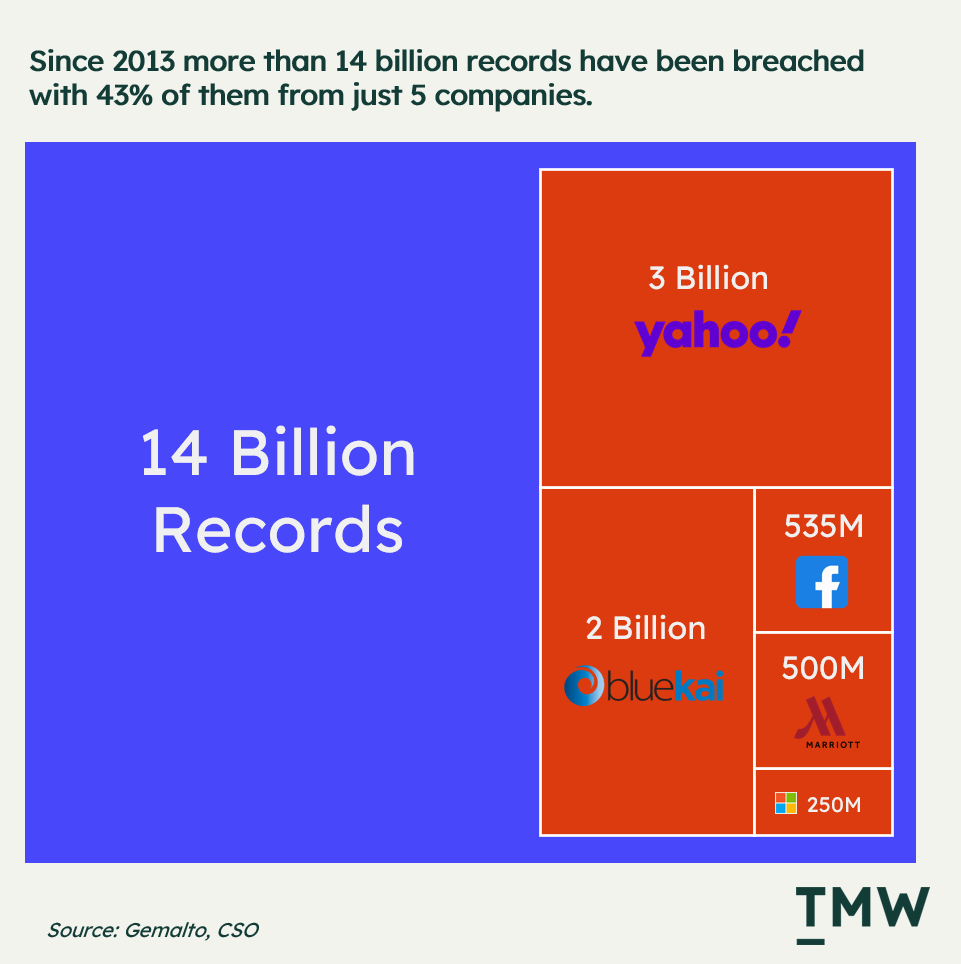
If you talk to your CSO or head of data security, I’m sure they’ll agree – protecting data is critical to the long term survival of any company. The Optus situation is our Chernobyl for Australian data practices. All it takes is one major breach to completely change both consumer sentiment and compliance rules. As Paul Smith, technology editor for the AFR suggests:
“For years, business leaders have been talking of data as the “new oil”, hoovering up all they can into “big data” systems to be mined for any commercial advantage possible. But now they may be forced to dispose of what they don’t need, or fined more punitively if they misuse or lose what they have.”
- Paul Smith, AFR
It’s clear that by now, perhaps the idea that data is oil was not the right metaphor. But how did we get to this single-lane view of data as a raw resource to be extracted, refined, and used to create value? It starts with obsession.
Data obsession
Our incomplete definition of data is not because of a lack of talking about it. Join any marketing team and you’ll hear things like “we’re data-driven!” All day long. The problem is that most of what we talk about when we talk about data is its value – how it can be used for commercial purposes. For years, we’ve been talking a lot about what data can do for us, but not enough about its role in our companies, societies, and in our very lives.
Amazon is one of the main companies to popularize the concept of being “data-driven” which is to make decisions by being directly informed by data – to understand your customer or business better. And since then, almost every company has embraced this mantra, while mostly ignoring the often ruthlessness and dehumanizing nature of only following the answers data provide. For more than a decade we’ve wanted to become more data-driven, but we’ve never stopped to think about where it’s driving us.
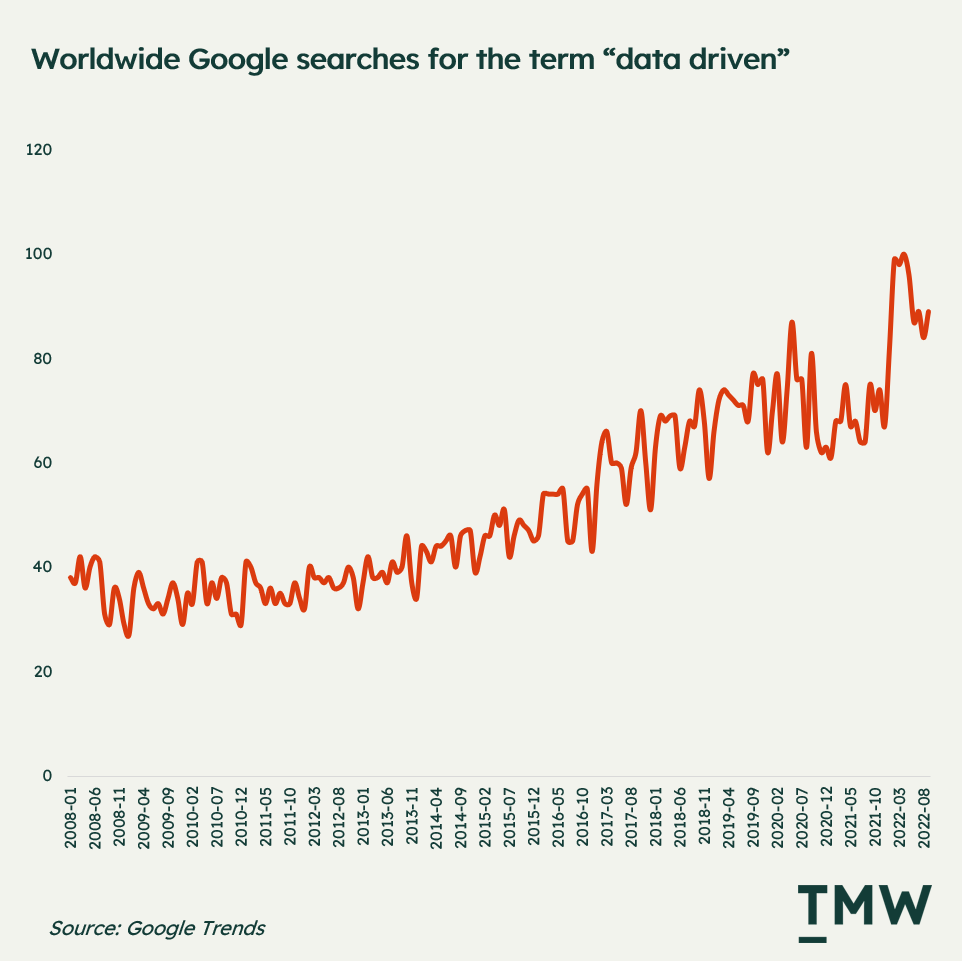
We are collecting a lot of it too. In the past, collecting data used to be harder to do, if you had a lot of it, you had to somehow get it into an on-premises server, requiring engineering teams and a lot of work to ensure it gets there and is managed properly. But over the past few years, the cloud made data hoarding more accessible.
Recently it became a good idea to collect all the data you can. And with it the incentives aligned with cloud storage providers like AWS, Snowflake, Azure, and Google Cloud Platform - bringing data to these platforms creates costs in compute and storage. And the theoretical idea behind collecting and sending data to cold storage works as a kind of insurance proposition – you better not delete it, because you never know when you might need it for a use case, or an analytics dashboard.
In this way, data as an asset has become one of the prevailing ideas to influence Martech and because of these beliefs, spending on data storage in the cloud is set to almost double by 2025, growing beyond a trillion dollar industry.
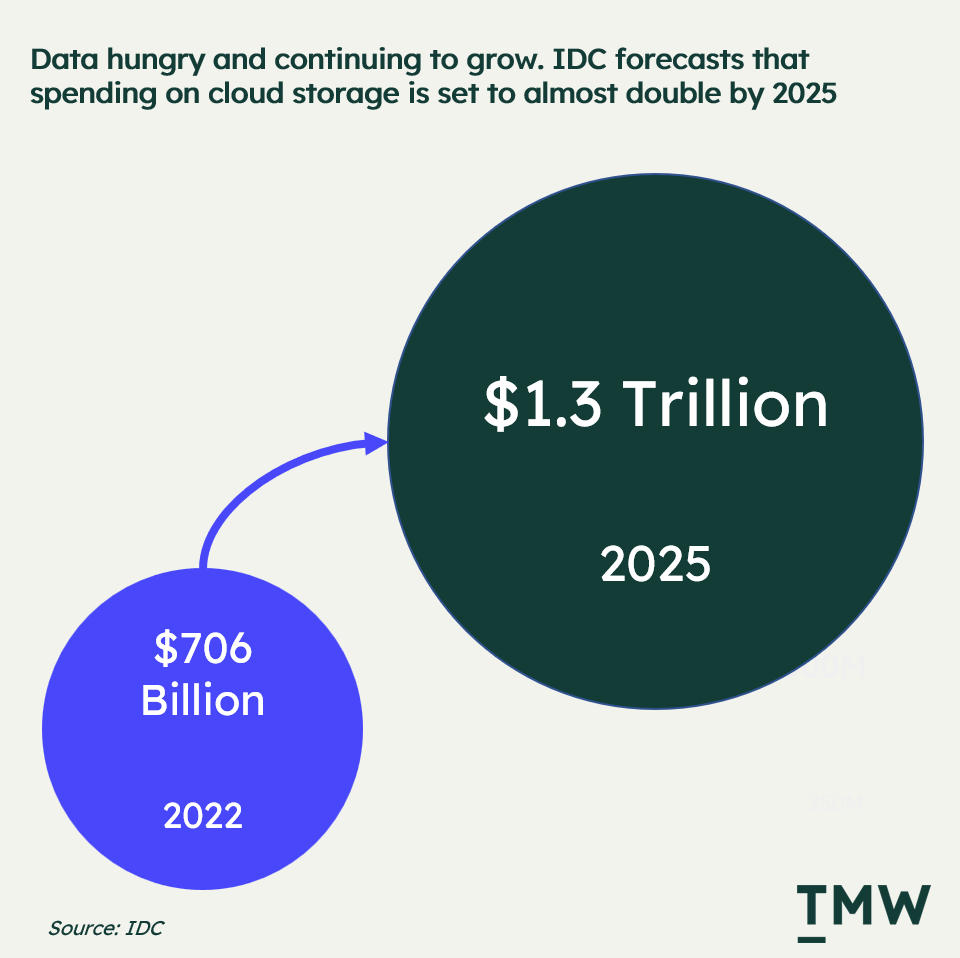
Our obsession with collecting data is driving trillion-dollar industries in a way that we’ve never seen before. Yet despite this our understanding of data is incomplete. We’re still in the early phases of grappling with how we understand what data is to us and to our companies. Most definitions we see today are superficial at best and misleading at worst.
The dimensions of data
In a recent LinkedIn post asking about the right metaphor for data, the answers I got were numerous: Oil, sand, asset, language, compass, food, clay, and breadcrumbs. The interesting thing here is that all of these metaphors try to quantify data and turn it into a natural resource that can be mined, extracted, and refined into something useful. And that’s somewhat true – data can be useful to gain insights about your business, it can enable a marketing campaign, or help serve customers better.
But the problem is that data is far more than a crude resource that we extract from the earth. Oil or sand are neutral resources that have nothing to do with knowing things about us, its influence on how we grasp realities in our business, or how we communicate with people. Data as oil or sand is an empty metaphor that only conveys one solitary dimension of data – the promise of value when refined. But how does data change when we consider it as something that is part of us?
Data is inherently personal – it’s information about us. Our behaviors, transactions, location, friends, lovers, reading habits, watching preferences, travel, and employment are far from crude resources. Of course, data is about all kinds of things. But the core function of it in marketing technology is that data is bits of information that make up us as people. Data is us, all of us.
That means that data needs to go beyond the metaphors we have today. If data is personal, then there’s a human element to it that is important. In the way we treasure photos of relatives' past or old videos of when we were kids – data is what we leave behind. Most companies see this as the necessary resource for commercial outcomes, but for us, it’s about our lives, wants, and dreams and how we’re enacting them in often mundane situations like searching google, buying something online, or messaging a friend. If we dehumanize data, then we risk dehumanizing people.
Data has four edges
Data has four main characteristics. It enables business growth, helps us serve customers, keeps people safe, and provides the raw materials for insight into your business. Understanding data from this standpoint gives us the essential functions, but also the tradeoffs of focusing on one edge over the others. Growth without safety is no growth at all, and safety without knowledge is poking around in the dark.
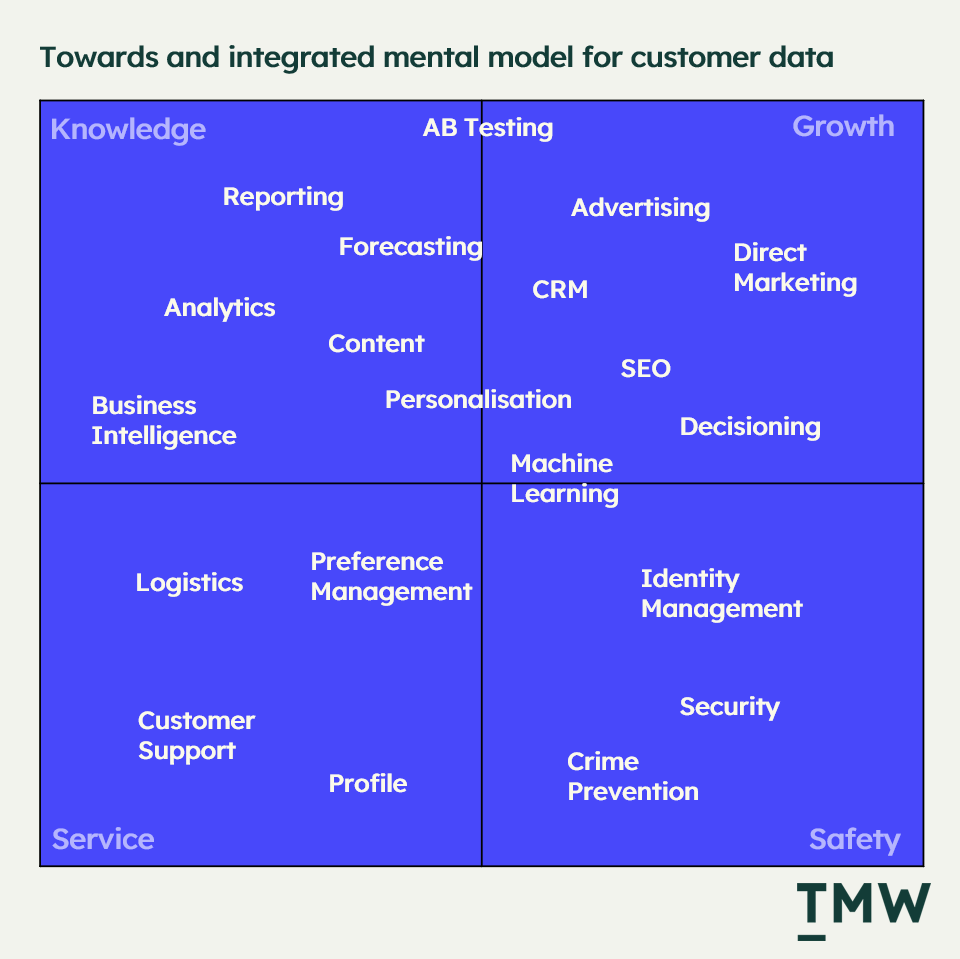
So what is data? I would say that data is information, and information is about as diverse as the world is – it comes in almost infinite forms and shapes. Sure, this is not as memorable as saying that data is oil, but the role of data in any company is about as multivariate as we are as people.
To us working in the marketing technology industry, data takes the form of the customer. If we over-index on either one of these characteristics, then we miss something important and essential. The value of data is not in its potential to generate a return on investment, but in the way it can help us learn, serve our customers and keep them safe.
When philosopher Sir Francis Bacon published his work, Meditationes Sacrae in 1597, he coined a now-famous concept – knowledge is power. It was true 400 years ago as it is today, but instead of calling it knowledge, we call it data. If we are to truly harness the power of data, we must first understand its power in all areas of business.
📈Chart Of The Week
How much does a metaverse cost? According to The Information - Meta’s investment into 3D virtual worlds is set to cost more than $70 billion, or more than twice the spending on autonomous vehicles. On the other side of this, I wonder how this kind of investment would pay off if invested into content moderation, figuring out a better post-cookie technology, or even just making the existing social apps a better experience. Give it five years and we’ll see if this kind of investment into a long shot like VR-powered virtual experiences will pay off. Link
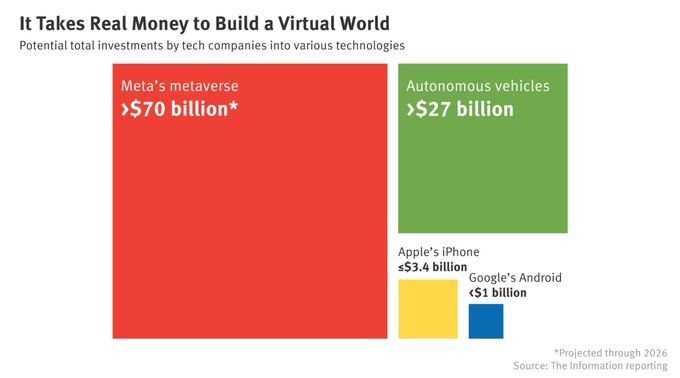
📰 Latest Developments
Bytedance goes VR. An interesting shift into VR puts the company on a competitive course to figure out the mass adoption use case for virtual worlds (aka the metaverse). It’s not immediately clear how it might integrate, if at all, with TikTok or its other social apps. Link
Texas and Big Tech. Should big online platforms have first amendment rights in their editorial decisions? A Texas law suggests and recent ruling states that they shouldn’t which means that content moderation won't be possible if it's enforced. You can probably guess what the consequences will be. Link
Shutterstock and AI. Today in unintended externalities caused by generative AI apps: Shutterstock has moved to block the monetization of AI illustrations and imagery added to its marketplace. I only wonder how long it will be until you won’t be able to tell the difference. The clock is ticking on the creative industry. Link
📚 Reading
Stepping back from social commerce. A once promising concept to merge social media and ecommerce was popularized in places like China and South East Asia, in the west, social platforms attempted to replicate its success, but it didn’t work. Why? Link
The boring curve. The moment you start a social network is the moment you start its eventual decline into entropy, malaise and ultimately its irrelevance. Link
Snowflake’s pursuit of Adtech. A strategic analysis of how Snowflake is attempting to enter the Adtech industry through trojan horses like “the modern data stack.” Link
🔢 Data & Insights
Stepping back from social commerce. A once-promising concept to merge social media and eCommerce was popularized in places like China and South East Asia. But in the west, social platforms attempted to replicate its success, but it didn’t work. Why? Link
The boring curve. The moment you start a social network is the moment you start its eventual decline into entropy, malaise, and ultimately its irrelevance. Link
Snowflake’s pursuit of Adtech. A strategic analysis of how Snowflake is attempting to enter the Adtech industry through trojan horses like “the modern data stack.” Link
💡 Ideas
Conversion APIs and their role in a cookie-less world. How marketers might measure advertising effectiveness as other tracking options become limited. Link
Casey Newton on synthetic media. More research on the use of AI tools to power design, illustration, video content, and copywriting and what the world would look like if these tools become the default tools. Goes well with TMW #096. Link
Screenshot shopping. Google has launched a tool that allows you to use your screenshots to search for products. This is an entirely new search pattern for consumers and something that marketing can easily leverage. Prepare yourself for “screenshot now” CTAs in your social feeds. Link
✨ Weird and Wonderful
Is AB testing supposed to be unethical? The NYTs wrote an article on LinkedIn’s unethical social experimentation using AB tests, while their own digital team runs hundreds of tests a year on their paywall and headlines. It’s either willful ignorance or the editorial and analytics teams are not in the same meetings. Read both side by side. LINKEDIN. NYTs.
Walmart in the metaverse. Walmart launched its metaverse concept this week, and someone captured this very sad video of their CMO doing a talk on a virtual stage to absolutely no one. Meanwhile… Chief Metaverse Offers are making $1 million a year off big brands. WALMART.$1 MILLION.
Reshaping website content. If everyone could do this, how would it change web design? Link
Stay Curious,
Make sense of marketing technology.
Sign up now to get TMW delivered to your inbox every Sunday evening plus an invite to the slack community.
Want to share something interesting or be featured in The Martech Weekly? Drop me a line at juan@themartechweekly.com.
